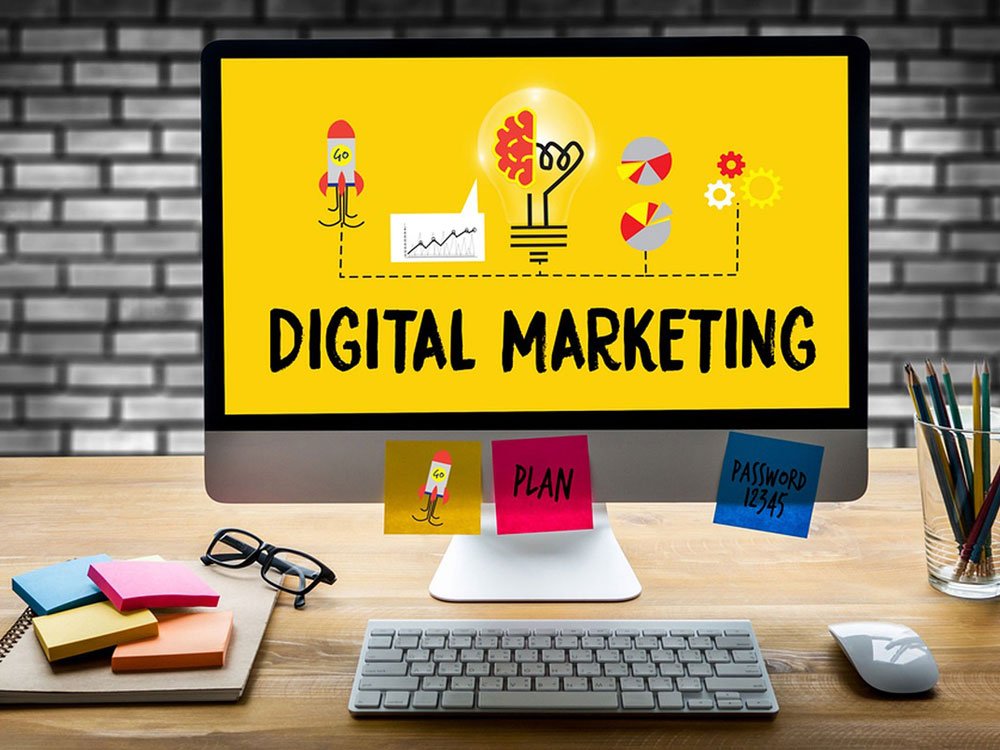What is digital marketing?

Digital marketing is a dynamic and ever-evolving field that encompasses a wide range of strategies and tactics aimed at promoting products or services using digital channels. In this comprehensive exploration, we will delve into the various aspects of digital marketing, including its definition, key components, strategies, and its impact on businesses in today’s digital age.
Definition of Digital Marketing
Digital marketing can be defined as the use of digital technologies and channels to connect with current and prospective customers to promote products or services. Unlike traditional marketing, which relies on offline channels such as print media, television, and direct mail, digital marketing leverages online platforms and technologies to reach and engage target audiences more effectively.
Key Components of Digital Marketing
Digital marketing comprises a multitude of components, each playing a crucial role in achieving marketing objectives and driving business growth. Some of the key components of digital marketing include:
- Website: A company’s website serves as the foundation of its digital presence and is often the first point of contact for potential customers. A well-designed and optimized website not only provides information about products or services but also serves as a platform for lead generation, customer engagement, and sales conversion.
- Search Engine Optimization (SEO): SEO is the process of optimizing a website to improve its visibility and ranking in search engine results pages (SERPs). By optimizing various on-page and off-page factors, such as keywords, meta tags, and backlinks, businesses can attract organic traffic and increase their online presence.
- Content Marketing: Content marketing involves creating and distributing valuable, relevant, and consistent content to attract and engage a target audience. Content can take various forms, including blog posts, articles, videos, infographics, and social media posts, and is aimed at educating, entertaining, or inspiring audiences while subtly promoting products or services.
- Social Media Marketing: Social media marketing involves using social media platforms such as Facebook, Instagram, Twitter, LinkedIn, and YouTube to connect with audiences, build brand awareness, and drive engagement. Social media allows businesses to share content, interact with followers, run targeted advertising campaigns, and measure performance metrics.
- Email Marketing: Email marketing is a powerful tool for nurturing leads, retaining customers, and driving sales. By sending targeted and personalized emails to subscribers, businesses can deliver relevant content, promotions, and offers directly to their inbox, fostering customer relationships and encouraging repeat purchases.
- Pay-Per-Click (PPC) Advertising: PPC advertising involves paying for ads to be displayed on search engines or other digital platforms, with advertisers only paying when a user clicks on their ad. Popular PPC platforms include Google Ads (formerly Google AdWords) for search ads and display ads, as well as social media advertising on platforms like Facebook Ads and LinkedIn Ads.
- Affiliate Marketing: Affiliate marketing is a performance-based marketing strategy where businesses reward affiliates (publishers or influencers) for driving traffic or sales to their website through affiliate links or promotional codes. Affiliates earn a commission for each successful referral, incentivizing them to promote products or services to their audience.
- Analytics and Data Analysis: Analytics and data analysis play a crucial role in digital marketing by providing insights into audience behavior, campaign performance, and ROI. By tracking key metrics such as website traffic, conversion rates, click-through rates, and customer lifetime value, businesses can make data-driven decisions to optimize their marketing efforts and maximize results.
Strategies and Tactics in Digital Marketing
Digital marketing encompasses a wide range of strategies and tactics, each tailored to achieve specific marketing objectives and reach target audiences effectively. Some common strategies and tactics in digital marketing include:
- Content Strategy: Developing a comprehensive content strategy involves creating high-quality, relevant, and engaging content to attract and retain target audiences. Content can be optimized for search engines (SEO), shared on social media, or distributed through email marketing campaigns to reach a wider audience and drive engagement.
- Social Media Engagement: Engaging with followers and building a strong presence on social media platforms is essential for fostering brand loyalty and driving customer engagement. Social media engagement involves responding to comments, messages, and mentions, sharing user-generated content, and running interactive campaigns such as polls, contests, and Q&A sessions.
- Search Engine Marketing (SEM): SEM involves using paid search advertising (PPC) to increase visibility and drive traffic to a website through search engines like Google and Bing. Advertisers bid on keywords related to their products or services, with ads displayed at the top of search results for relevant queries, driving targeted traffic to their website.
- Email Automation: Email automation involves setting up automated email campaigns to deliver targeted messages to subscribers at the right time and frequency. Automated emails can be triggered by specific actions or events, such as website visits, email opens, or purchases, and can include welcome emails, abandoned cart reminders, product recommendations, and follow-up sequences.
- Conversion Rate Optimization (CRO): CRO is the process of optimizing a website or landing page to improve conversion rates and drive more desired actions, such as purchases, sign-ups, or downloads. Techniques used in CRO include A/B testing, multivariate testing, heatmaps, and user surveys to identify and address barriers to conversion.
- Influencer Marketing: Influencer marketing involves partnering with influencers or content creators with a large and engaged following to promote products or services to their audience. Influencers can create sponsored content, reviews, or endorsements, helping businesses reach new audiences and build credibility and trust with their target market.
- Remarketing and Retargeting: Remarketing and retargeting involve targeting users who have previously interacted with a website or engaged with a brand but did not complete a desired action, such as making a purchase. By serving targeted ads to these users across various digital channels, businesses can re-engage them and encourage them to return and convert.
- Mobile Marketing: With the proliferation of smartphones and mobile devices, mobile marketing has become increasingly important for reaching consumers on the go. Mobile marketing tactics include mobile-responsive website design, SMS marketing, mobile apps, and location-based targeting to deliver relevant and personalized experiences to mobile users.
Impact of Digital Marketing on Businesses
Digital marketing has had a profound impact on businesses of all sizes, revolutionizing the way they reach and engage with customers, drive sales, and measure marketing performance. Some key benefits and impacts of digital marketing on businesses include:
- Increased Reach and Visibility: Digital marketing allows businesses to reach a global audience and expand their market reach beyond traditional geographic boundaries. With the proliferation of digital channels and platforms, businesses can connect with customers wherever they are, increasing brand visibility and awareness.
- Targeted Advertising: Digital marketing enables precise targeting of advertisements to specific demographics, interests, behaviors, and purchasing intent. By leveraging data and analytics, businesses can create highly targeted campaigns that resonate with their target audience, resulting in higher engagement and conversion rates.
- Cost-Effectiveness: Compared to traditional marketing channels such as TV, radio, and print media, digital marketing offers a more cost-effective way to reach and engage with customers. With digital advertising platforms offering flexible pricing models such as pay-per-click (PPC) and pay-per-impression (PPI), businesses can optimize their marketing budgets and achieve better ROI.
- Measurable Results: One of the key advantages of digital marketing is its ability to track and measure campaign performance in real-time. Digital analytics tools provide insights into key metrics such as website traffic, conversion rates, engagement levels, and customer behavior, allowing businesses to optimize their marketing efforts and make data-driven decisions.
- Improved Customer Engagement and Relationships: Digital marketing enables businesses to interact with customers in real-time and provide personalized experiences across various digital channels. By engaging with customers through social media, email, and other digital touchpoints, businesses can build stronger relationships, foster brand loyalty, and drive repeat purchases.
- Enhanced Customer Experience: Digital marketing allows businesses to deliver seamless and personalized experiences to customers at every stage of the buyer’s journey. From targeted ads and personalized recommendations to responsive websites and interactive content, businesses can create positive and memorable experiences that drive customer satisfaction and loyalty.
- Competitive Advantage: In today’s competitive marketplace, digital marketing can provide businesses with a competitive advantage by enabling them to differentiate themselves and stand out from competitors. By leveraging innovative digital strategies and tactics, businesses can gain market share, attract new customers, and outperform competitors.
- Adaptability and Flexibility: Digital marketing offers businesses the flexibility to adapt and pivot their marketing strategies quickly in response to changing market conditions, consumer trends, and competitive landscapes. With digital channels and platforms constantly evolving, businesses can experiment with new approaches, iterate on existing campaigns, and stay ahead of the curve.
Digital marketing is a multifaceted discipline that encompasses a wide range of strategies and tactics aimed at promoting products or services using digital channels. From search engine optimization (SEO) and content marketing to social media advertising and email automation, digital marketing offers businesses a cost-effective and measurable way to reach and engage with customers in today’s digital age. By leveraging the power of digital technologies and data-driven insights, businesses can drive sales, foster customer relationships, and achieve their marketing objectives more effectively than ever before.

